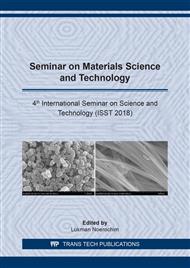p.193
p.199
p.209
p.215
p.221
p.228
p.234
p.240
p.246
Reversible Adsorption-Desorption of Zn (II) and Pb (II) in Aqueous Solution by Thermosensitive-Sulfobetaine Gel
Abstract:
Copolymer gel contains zwitterionic betaine N,N-dimethyl(acrylamidopropyl) ammonium propane sulfonate (DMAAPS) and thermosensitive N-isopropylacrylamide (NIPAM). Later, they were employed as reversible Zn (II) and Pb (II) adsorption-desorption in aqueous solution. The effects of temperature, monomer, cross-linker concentration, and type of ions on the swelling degree, and the adsorption amount of Zn (II) and Pb (II) ions onto the gel were investigated. In addition, the adsorption-desorption reversibility of ions was also examined. The adsorption ability and swelling degree of the gel were significantly influenced by temperature, monomer, and cross-linker concentrations. The amount of ions adsorbed onto the gel was inversely proportional to its temperature at various monomer concentrations. The swelling degree of the gel with NIPAM to DMAAPS molar ratio of 9:1 and 8:2 decreased with the increase of the temperature. However, for the gel prepared with NIPAM to DMAAPS molar ratio of 7:3, the swelling degree increased significantly as the temperature increased. It was obtained that the swelling degree of the gel in Zn(NO3)2 solution was higher than the swelling degree of the gel in Pb(NO3)2 solution. In contrast, the amount of ions adsorbed onto the gel in Zn(NO3)2 solution was slightly lower than in Pb(NO3)2 solution. Copolymer gel prepared with NIPAM to DMAAPS molar ratio of 8:2 exhibited the highest adsorption ability and swelling degree in Zn(NO3)2 and Pb(NO3)2 solutions. In addition, the copolymer gel of NIPAM-co-DMAAPS showed the reversible adsorption-desorption ability toward ions up to three cycles.
Info:
Periodical:
Pages:
221-227
Citation:
Online since:
July 2019
Price:
Сopyright:
© 2019 Trans Tech Publications Ltd. All Rights Reserved
Share:
Citation:


